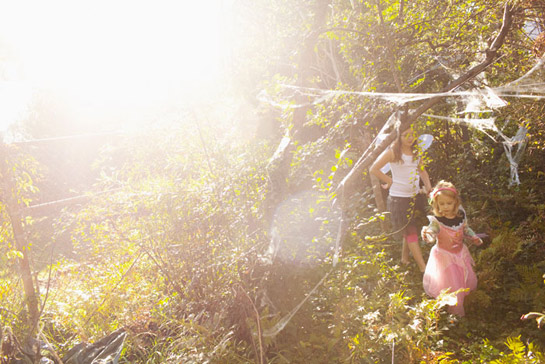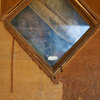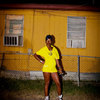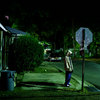A Conversation with Matt Eich

Still in his mid-twenties, Matt Eich has an impressive list of achievements under his belt already. I had a general sense of curiosity about his work, and I figured the best way to learn more about it - and the person behind the camera - was to ask some questions. Find our conversation below. (more)
Jörg Colberg: You’re a founding member of LUCEO. Can you talk a little bit about the background and ideas of LUCEO? Why another agency?
Matt Eich: LUCEO formed in 2007 as a collective of six photographers. We knew one another’s work through the online photo community, primarily the A Photo A Day listserv, and were all on the same path together, just beginning to work as photographers. In 2009 we became a business and now operate as a cooperative, with five of the founders and one newer full member who joined us in 2009. Some of us had previous experience with agencies, but all of us were fairly new to photography and interested in creating a very intimate and supportive community for our work as well as a platform that would allow us to counteract some of the trends within photo agencies and the industry at large that we felt were not sustainable for photographers. So in short, we don’t see LUCEO as “another agency,” but an evolution of what presently exists.
JC: What were/are some of those trends within photo agencies and the industry at large? And how do you counteract those trends with LUCEO?
ME: Some agencies (though certainly not all) seem stuck in a way of doing business that hasn’t kept up with the changing media industry. We no longer need a representative to pick up film from the plane or answer the phone. Our clients reach out to us directly and usually prefer one-on-one relationships with photographers. The standard agent cut in the photo world averages 30-35%. This is three times as much as a musician’s agent charges, why? An agent helps manage your contracts, but then you don’t know how to handle them for yourself at the end of the day. After a while for me it didn’t make sense to continue contributing 35% of my meager income to support a business that I had no say in that was looking out for their bottom line before their photographers. I wanted to be part of something that allowed for me to have a voice and to be investing my hard-earned dollars in something that I believe in instead of a business model that is just treading water.
Within LUCEO we represent one another. We go to meetings with clients together and speak about one another’s work as comfortably as our own. We actively subvert the lone wolf mentality that pervades photography by combining resources and supporting one another creatively and financially. There is also the “strength in numbers” argument, which is valid. Lots of organizations have a way of introducing new contracts and then twisting their contributor’s arms to sign it. It is much easier to have a reasonable conversation about finding a middle ground when the interests of six photographers are on the table, not just one. This all might sound a bit socialist but our form of cooperative is borrowed from a model that is applied to everything from farmers to car dealers. We have no intentions of reinventing the wheel; we’re just trying to oil it and make it work for the path we are on.
JC: It would seem that given all the problems it faces - a lot of them business related, but there are more - photojournalism is a very tough field to get into. What made you decide to become a photojournalist?
ME: Though I studied photojournalism I don’t believe the title fully encapsulates my work, or that of my colleagues. It can be a rather limiting term but tends to be a catch-all for the kind of work that I am drawn to, which is try and distill a scene or to “thin-slice” moments as they occur, to use a term coined by Malcolm Gladwell in “Blink.” In high school I played music in some bands and by graduation I was burned out on the petty rock star drama that can occur within a band. I felt a strong desire to create something that matters that is greater than myself. This is what drew me to photography in the first place. Starting out, I found myself intrigued by the realism of reportage, the grit and the drama offered in pictures by people like Richards, Nachtwey and others. I used to bristle at the term “artist,” but in time I’ve learned to get over it, it’s more applicable than “photojournalist.” Like most, I’ve gone through phases where I’ve been influenced by a variety of predecessors. One phase in particular included Soth, Jacob Aue Sobol and Eggleston simultaneously. Most of these folks work within the documentary practice, but are less beholden to the newsworthiness of a situation. I still admire the idealism of photojournalism, the belief that an image in the right context can change people’s minds and ultimately, the world around us.
JC: Can it? Can an image - in the right context (whatever that might be) - change people’s minds?
ME: This has proven true in the past with images like Nick Ut’s napalm girl from Vietnam. Photographs of discovery, exploration, of humanity in its brightest and darkest moments have helped to form opinions and influence the civilized world for the past century. I think the commonality behind all of the images that have had a weighty impact on opinion is that they aren’t about the photographer. Certainly the photographer has a perspective, a voice, but the photographs that speak the loudest resonate to a wide audience because the vision or voice has become a conduit for something larger than itself. The flipside of photography is its ability to be read multiple ways. Another image often said to have altered public opinion is Eddie Adams’ execution photograph from Vietnam. Adams however regrets the photographs and its consequences and is quoted as saying “Still photographs are the most powerful weapon in the world. People believe them; but photographs do lie, even without manipulation. They are only half-truths. …What the photograph didn’t say was, “What would you do if you were the general at that time and place on that hot day, and you caught the so-called bad buy after he blew away one, two or three American people?”
JC: Let’s talk a little about “Baptist Town,” one of your ongoing projects. What is the background? How did you find out about the town and its people?
ME: Originally I was sent to Mississippi by Michael Wichita, Director of Photography at AARP Bulletin for a story about rural healthcare. After a three-day trip, I knew I was just scraping the surface of something much larger and convinced Michael to send me back for five more days. I began bringing prints back to the people I was photographing, and the doors opened a little more. I returned three more times in 2010 and twice thus far in 2011 for a total of about 25 days on the ground. My primary focus to this point has been one neighborhood called Baptist Town in the town of Greenwood, cut off on all sides by train tracks. The place is a pocket for poverty, crime and violence. It is also an incredibly historic community, one where the neighborhood is knit together like family. It is beautiful in its own way, and brimming with life. From here, I plan to branch out to show the more affluent and predominantly white side of town and examine the similarities and differences between daily life in both places.
The South lives under a legacy of segregation and racism that causes interesting ripple effects in the community. Now it is not really about black and white, it’s more about the economic disparity, which is an effect of the history. 50.9 percent of the black population lives below the poverty line, as opposed to 15 percent of the whites. The black community is largely distrustful of the whites, who more often than not don’t harbor ill will, just an unawareness of how dire their neighbor’s circumstances can be.
JC: I’m a little curious about your process of work. For this particular project, how has it evolved? And where or how do you look for new pieces of your story?
ME: My process is always evolving to fit the needs of the project, but when boiled down is pretty uncomplicated. I walk around in places where I don’t belong and if you’re there long enough, people will ask you what your deal is. I’m a small guy, rather unthreatening and don’t carry much gear, so people usually don’t pay me too much mind. I listen and share because communication is a two-way street. In a place like Baptist Town, I am called on to make photographs of people projecting a representation of themselves to the camera. “Yo Matt, take my picture” is usually how it starts before the hands come up, the head cocks to the side and I’m expected to record them as they want to be seen. Sometimes I just snap what they present to me, other times I pull them aside into some light or to a cleaner background to make it more collaborative. What I’m always striving for is time - less these passing photographs, snaps, portraits, street photos, but more what happens on porches and in kitchens and bedrooms. There people sit, talk, drink, smoke and live.
This pattern repeats itself over multiple visits. Each time I try to bring pictures back, to help people understand that I appreciate that they accept me and to show them how I see them. Eventually characters begin to emerge that I connect with and I try to get to know them and peel back the layers of their situation so I can get at a deeper truth than their age, race, occupation or socioeconomic standing. This usually takes a long time with many repeat visits. As my knowledge of a place changes, the story deepens. I start out most of the time as an outsider and eventually position myself as a “knowledgeable outsider” who is always on the fringe trying to step inside. Unless you are actually part of the story, there is no way to truly be an insider.
When it comes to the larger ideas, they stem from the unanswerable questions that always nag me after I leave a place where I have been making pictures and I let them evolve organically.
JC: You’re one of the first users of Emphas.is, a crowdfunding website for photojournalists. How/why did you decide to use crowdfunding?
ME: Baptist Town is one of the first projects I’ve worked on where I have been able to push the project out in multiple platforms to make it more viable from the outset. It began with an editorial assignment, I went out-of-pocket for a few trips then received a small grant, then sold some fine art prints, then crowd-funded a portion and most recently received a larger fellowship that will allow me to push into early next year. In my experience, relying on one market to support your projects or pay your bills is a bad idea. The idea is diversification in the ways we disseminate work will open up new ways to fund our projects. If a photographer can apply a consistent vision to anything handed to them what’s to stop them from pursuing editorial, commercial, advertising, fine art and grant writing simultaneously?
These projects are long-term and develop a life of their own and require different kinds of funding at different phases. Crowdfunding is perfect for a project at this stage because it gets a group of people intimately involved in its development. The backers form a crucial support group, not only financially but also creatively, because if done successfully, they feel invested in the work. I feel I haven’t been able to utilize the platform to its full extent yet, but hope to continue learning how to tweak the model to create value for the backers. Another part of why I decided to use Emphas.is in the beginning was that LUCEO wanted to be a part of the conversation about crowdfunding early on to help shape the dialogue. For the model to survive it needs to steer away from looking like charity and it needs to offer tangible incentives for the people who support your work.
 By
By 








